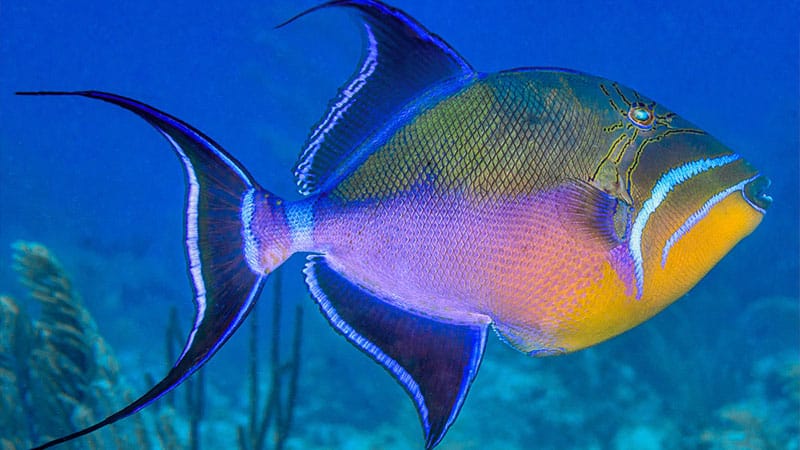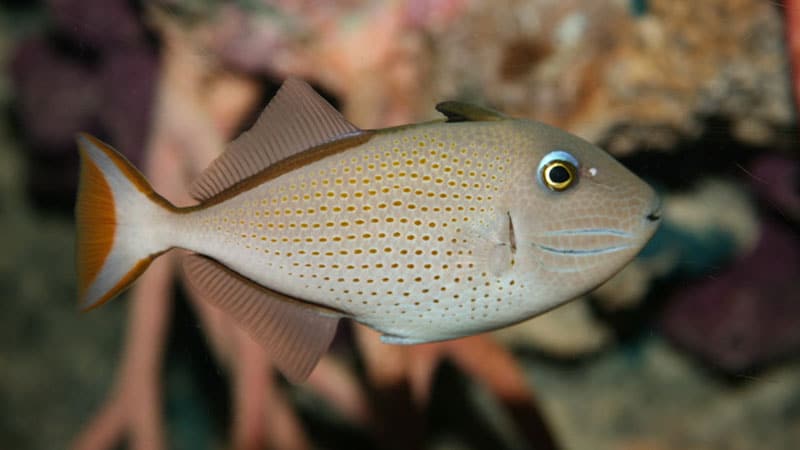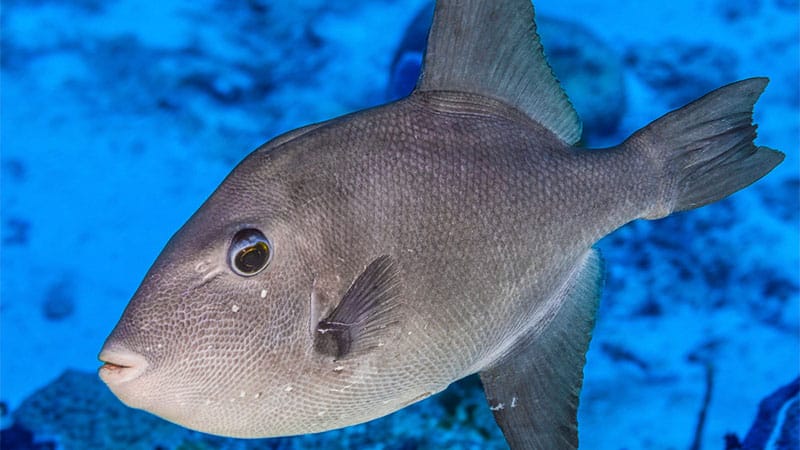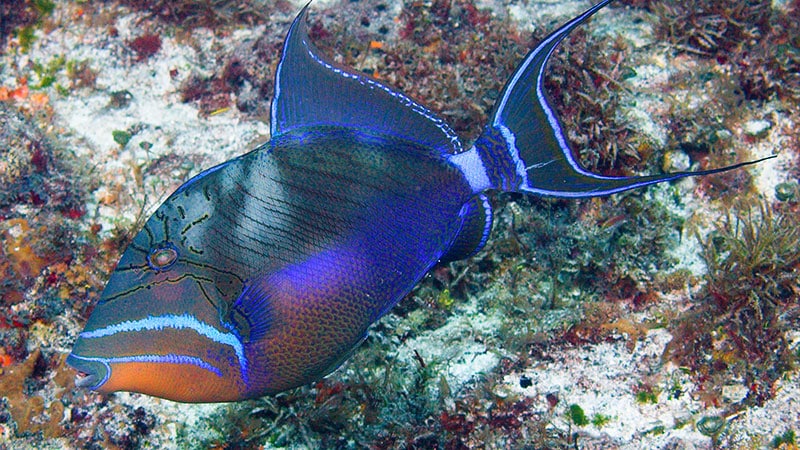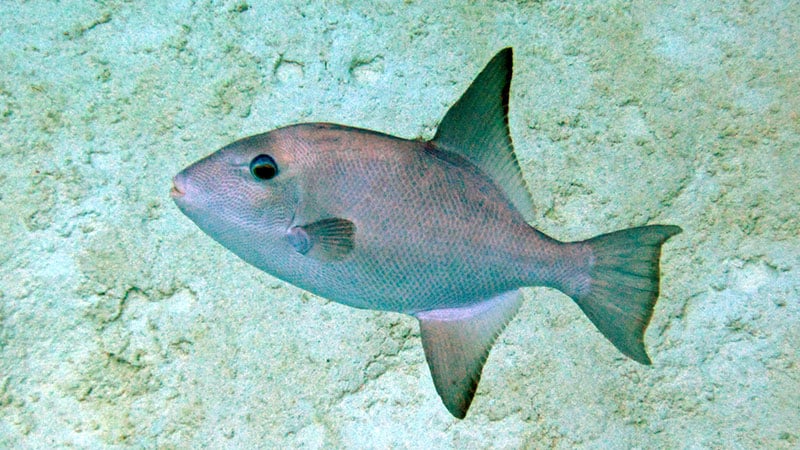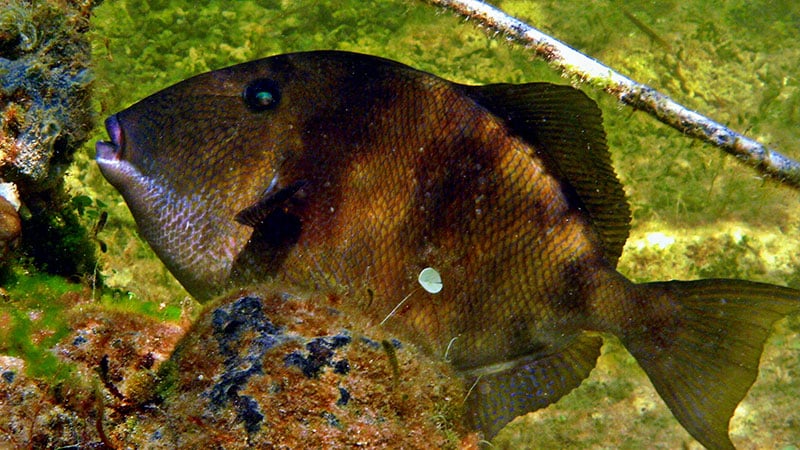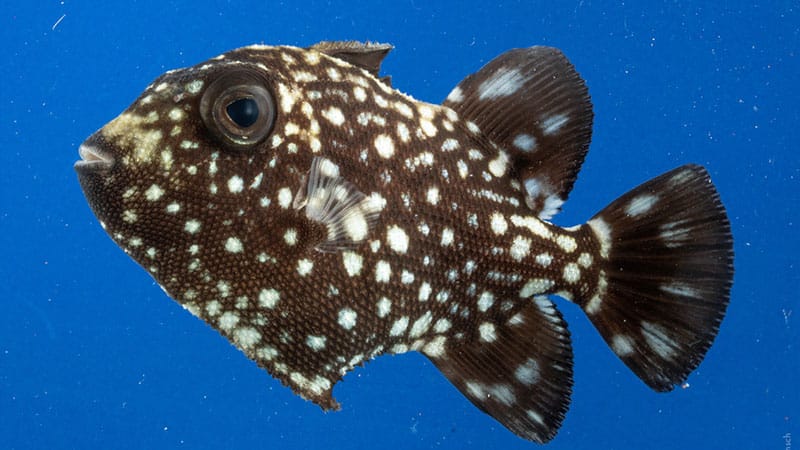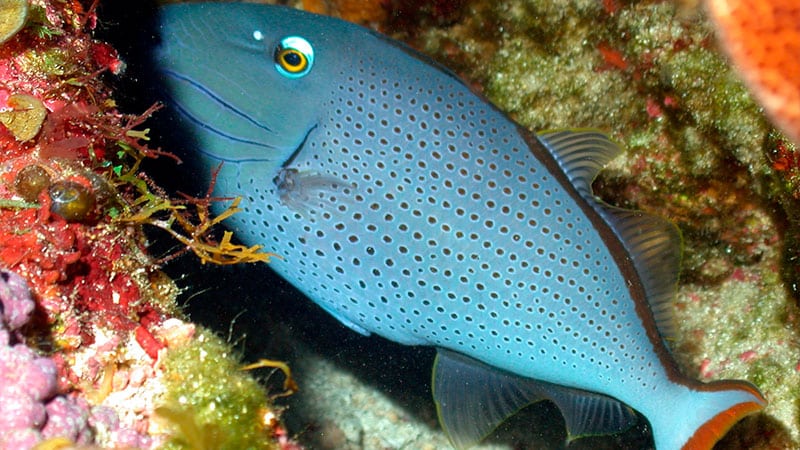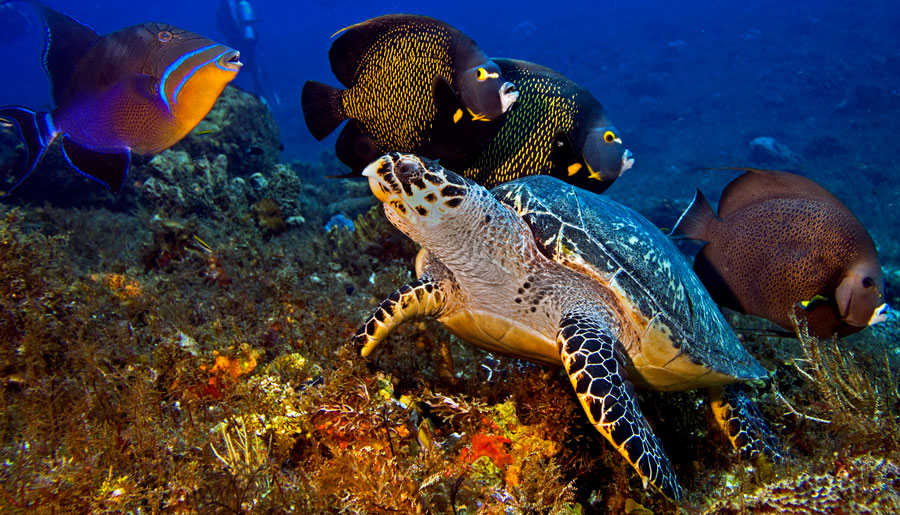3. Distribución y Hábitat del pez ballesta
Solo algunas pocas especies de pez ballesta son pelágicas (que pasan la mayor parte de su tiempo en aguas abiertas). La gran mayoría prefieren las aguas tropicales y subtropicales poco profundas y si puede ser, donde haya un buen arrecife cerca, como en el Caribe.
Aquí, pueden encontrar secciones del arrecife para refugiarse y áreas arenosas para construir sus nidos. Pero, ¡Ay de ti como se te ocurra acercarte a ellos!
4. ¿Qué comen los peces ballesta y quién se los come a ellos?
Estos peces ballesta aprovechan sus poderosas mandíbulas para alimentarse de diversas cosas duras, como crustáceos y moluscos. También les gusta darse un festín con erizos de mar y otros equinodermos. Algunas especies comen peces pequeños e incluso hay especies vegetarianas, que se alimentan principalmente de algas o plancton.
En contrapartida, a pesar de las espinas dorsales que poseen, a los meros, atunes y jureles les resultan deliciosos. Lo mismo ocurre con los tiburones punta negra de arrecife y otros tiburones, que también les parecen buenos.
5. La reproducción de los peces ballesta
Esta es la historia de los peces ballesta y sus estrategias de reproducción.
Todo comienza con un audaz macho que decide dirigirse a su lugar de reproducción favorito.
¡Ya está bien de estar solo! – Se dice. – Es hora de volver a tener descendencia.
Así que, una vez en el lugar elegido, se pone manos a la obra y construye con esmero su nido. (Lo hace lanzando chorros de agua con su boca y limpiando el sedimento que levanta con las aletas) Algunos machos de otras especies construyen verdaderas canalizaciones subterráneas ¡porque la defensa del territorio es un asunto serio! Los peces ballesta no permiten intrusos en su dominio y están dispuestos a luchar con uñas y dientes para protegerlo. Nuestro protagonista también.
Con su nidito construido, el valiente macho despliega sus encantos para cortejar a la hembra. –
– ¡Esa es perfecta! – Piensa.
Y comienza a danzar como un loco alrededor de la hembra, cambiando de color y llevándola al nido. Cuando ya la tiene convencida, los dos danzan en giros uno alrededor del otro. ¡Encantadores! ¿No?
En medio del frenesí, la hembra deja caer de 55.000 a 430.000 huevos en el nido y él los fertiliza. Mientras los huevos se desarrollan, las hembras se mantienen vigilantes como «supermamis» guardianas de los huevos, los limpian, los cuidan y les oxigenan lanzándoles choros de agua.
El macho no está lejos, pero su labor será la de espantar intrusos y vigilar que nadie se acerque desde la superficie. Incluso lanza bocados. Afortunadamente para los buceadores, la actitud agresiva del macho solo dura de 24 a 48 horas, hasta que nacen los alevines. Así que, si se os enfada un pez ballesta porque os habéis metido en su territorio buceando, desplazaos en horizontal y alejaos. ¡Mucho ojo con alejaros en vertical, la columna de agua forma parte de su territorio!
Distribution and Habitat of the Triggerfish
Only a few species of triggerfish are pelagic (spending most of their time in open waters). The vast majority prefer shallow tropical and subtropical waters, preferably with a nearby reef, such as in the Caribbean.
Here, they can find sections of the reef to take shelter in and sandy areas to build their nests. But beware if you dare to approach them!
What do triggerfish eat, and who eats them? These triggerfish utilize their powerful jaws to feed on various hard things, such as crustaceans and mollusks. They also enjoy feasting on sea urchins and other echinoderms. Some species eat small fish, and there are even vegetarian species that primarily feed on algae or plankton.
On the other hand, despite their dorsal spines, groupers, tunas, and jacks find them delicious. The same goes for blacktip reef sharks and other sharks, which also consider them good prey.
Reproduction of Triggerfish This is the story of triggerfish and their reproductive strategies.
It all starts with a bold male that decides to head to his favorite breeding ground.
«I’ve had enough of being alone!» he says. «It’s time to have offspring again.»
So, once in the chosen location, he gets to work and diligently constructs his nest. (He does this by squirting jets of water with his mouth and clearing the sediment he stirs up with his fins.) Some males of other species build intricate underground tunnels because defending their territory is a serious matter! Triggerfish don’t allow intruders in their domain and are willing to fight tooth and nail to protect it—just like our protagonist.
With his little nest built, the brave male displays his charms to court the female.
«That one is perfect!» he thinks.
And he begins to dance around the female like crazy, changing colors and leading her to the nest. Once convinced, the two engage in a swirling dance around each other. Enchanting, isn’t it?
Amidst the frenzy, the female drops anywhere from 55,000 to 430,000 eggs into the nest, and he fertilizes them. While the eggs develop, the females remain vigilant as «supermoms,» guarding, cleaning, caring for, and oxygenating the eggs by squirting them with water.
The male isn’t far away, but his job is to scare away intruders and ensure no one approaches from the surface. He even takes bites. Fortunately for divers, the male’s aggressive behavior lasts only 24 to 48 hours, until the fry hatch. So, if a triggerfish gets angry at you for entering its territory while diving, move horizontally and back away. Be careful not to swim vertically away, as the water column is part of their territory!




